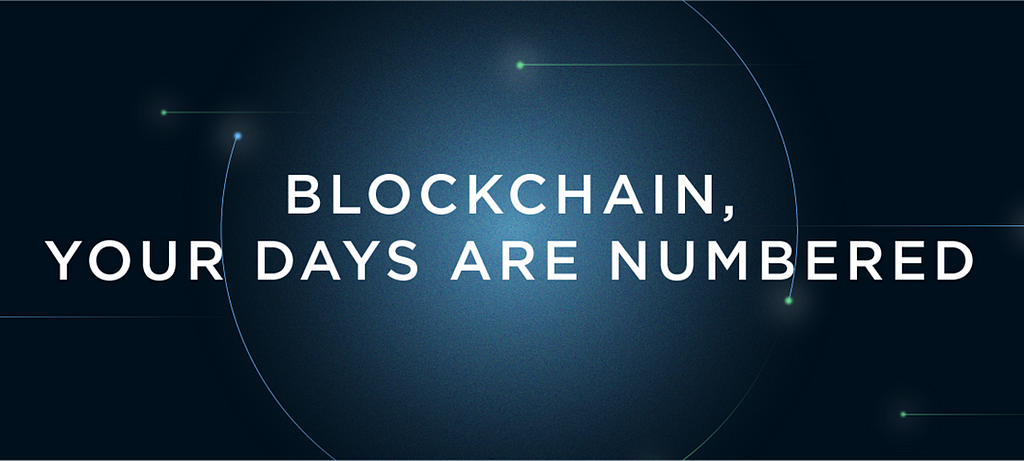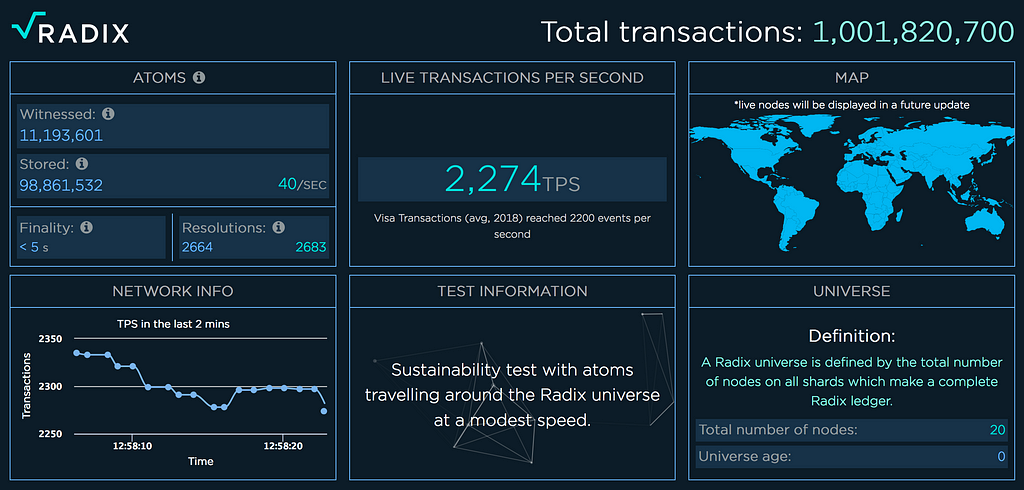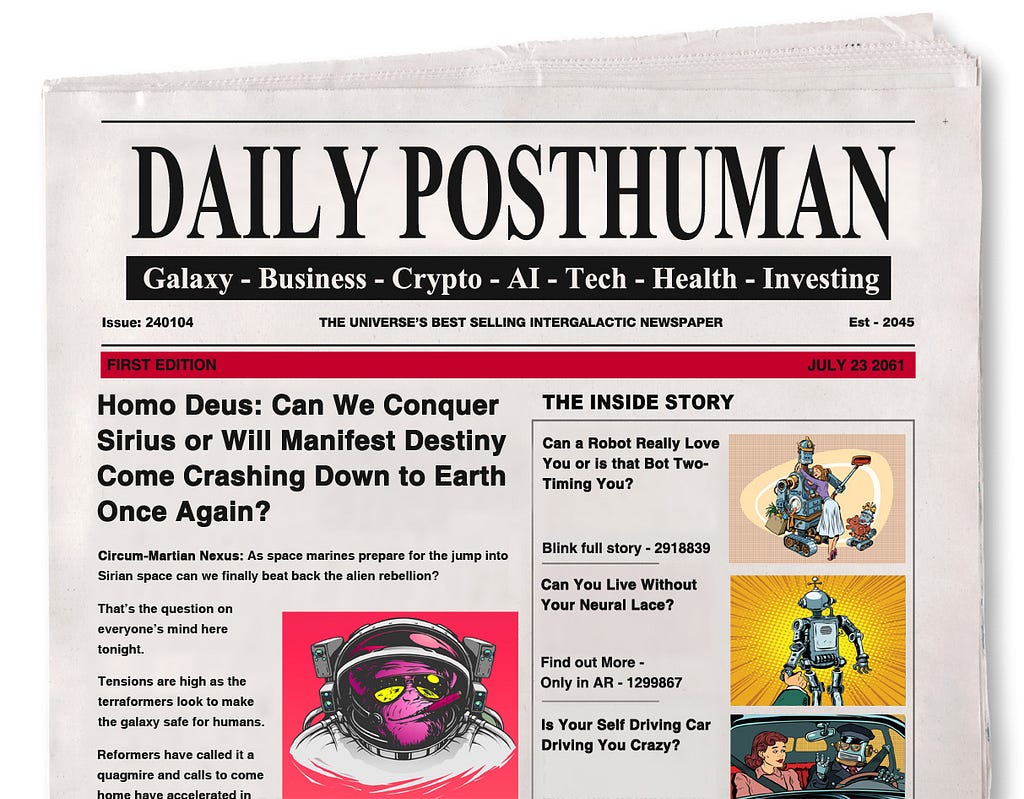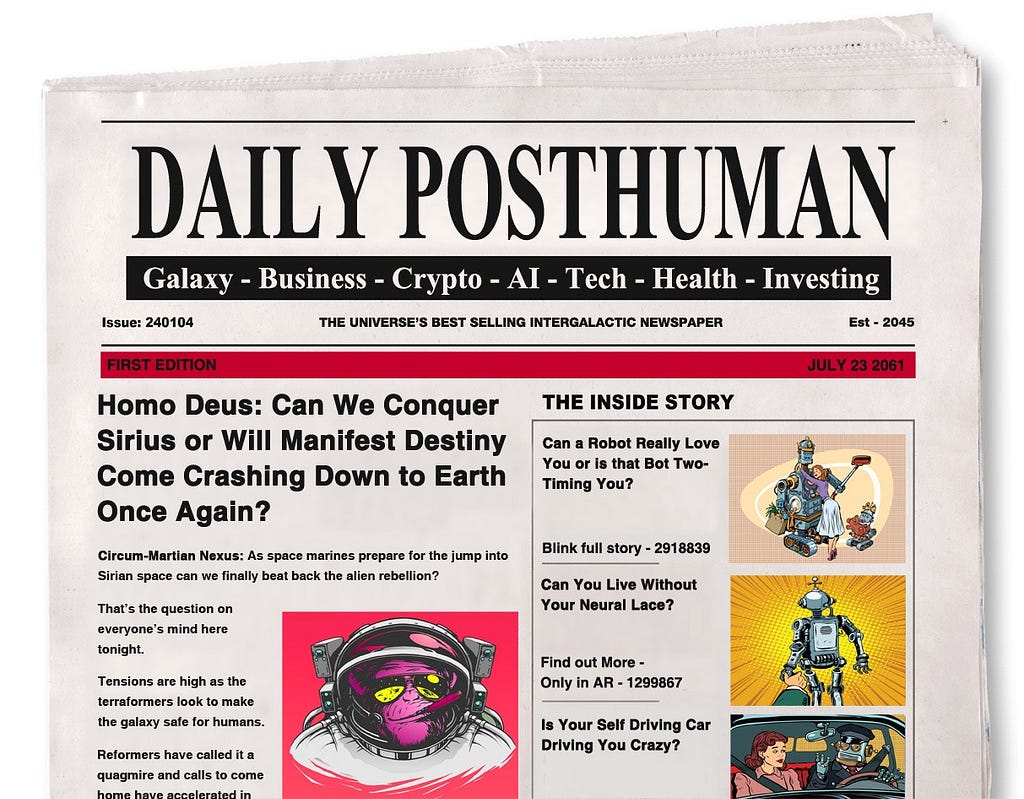Latest news about Bitcoin and all cryptocurrencies. Your daily crypto news habit.

############################################
NOTE: Check out the companion podcast to this piece on my show, The Daily Posthuman.
############################################
Blockchain, your days are numbered.
It’s a fantastic tag line that comes to us from the amazing Radix project, one of the first decentralized systems capable of scaling linearly and ripping through Visa level transactions per second, the holy grail of scalability in the crypto space.
Visa pushes 150 million transactions per day and 24,000 per second.
Bitcoin only pushes six per second.
 Live transactions per second on the Radix Explorer.
Live transactions per second on the Radix Explorer.
In alpha, Radix already smashes through 50 million transactions at 8,000 per second and it’s theoretically unlimited. The more nodes it has the more transactions it can crunch. Eventually, it could leave Visa in the dust.
It’s also one of the first non-blockchain, non-DAG crypto platforms.
But wait, aren’t blockchains the center of the crypto universe? Aren’t they essential to making the magic happen?
Nope.
Blockchains got it all started but they’re only the beginning of decentralized money. They’re the first solution, the breakthrough that made it all possible, but they’re just that, the first solution.
And first solutions rarely last.
Blockchains are the cave man’s fire of decentralized consensus technology. They’re the Model T.
To understand why, you just have to know there’s a massive difference between an iteration of technology and a category of technology. In the long run categories of tech succeed but iterations fail.
Take the steam engine category. The first concept steam engines didn’t work. Later iterations of steam machines exploded, killing or maiming people. Others broke down too easy and too often.
It took almost a thousand years before the first truly working steam engine revolutionized travel and work across the world. Not all tech takes that much time but it always takes longer than most people imagine, usually decades.
It’s hard to picture a world without the Internet but for twenty years almost nobody saw it taking off and becoming the planet spanning, life changing network it is today.
Iterations are the best ideas we have at a single point in time.
They’re subject to the limits of imagination and the technology and materials of the time when they’re invented. Tech skeptics struggle to see the future because they always mistake the iteration for the category. They see all the limitations and the flaws and they project them indefinitely into the future, as if nothing ever changes.
But the future is change.
Skeptics don’t realize there’s an engineer somewhere studying those flaws and trying to find answers, working through all the permutations in his or her mind, trying to discover the secret elixir. Eventually, one of them sees something everyone else in the world missed and a new iteration is born, better than anything that came before it.
Think about digital books. The first versions sucked. They were CD-ROMs and you had to read them on big, ugly CRT screens that burned holes in your retinas. They scratched easily, skipped, were slow to load and you couldn’t lug a giant computer around with you on the subway.
Over the years, a number of companies tried to make e-readers and they failed miserably. Even Apple tried and failed to make an early pad.
It wasn’t until Amazon used its massive market power and coupled it with e-ink technology and insanely long battery life that the true digital book revolution took off running with the Kindle. They had the perfect storm of market power and tech power to make it happen.
That’s how it goes with every technology.
The categories don’t fail, just the iterations.
Keys of the Crypto Revolution
A bunch of things are holding crypto back from mass adoption. I talked about the biggest ones in my article The Five Keys to Crypto Evolution but the absolute biggest one of all is how fast and far these systems can scale.
We know how to build centralized systems that push 150 million credit card transactions per day. It’s not easy but the big boys can do it. It takes time, money and knowledge. Those systems are the culmination of thirty years of technological breakthrough and human ingenuity.
But when it comes to decentralized systems, there’s no template for matching the power and performance of centralized systems. It’s a computer engineering problem of the highest order and we have no idea how to do it perfectly yet. We’ve only had Bitcoin for eight years. Eight measly years!
Cryptocurrency is brand new technology and we just don’t know everything it can and can’t do yet.
When people laugh at crypto and say it won’t work, it’s incredibly short sighted. There are no libraries to download, no papers to read that have it all figured out, no code to borrow. There’s no O’Reilly book on best practices for scaling decentralized systems. We’re still figuring it out and we’ve got a long way to go.
That’s what makes the Radix project so exciting.
They’ve hammered on the biggest problems in secret for six years, going through a thousand ups and downs and pushing past dead ends and false starts to get to where they are right now, an alpha launch with real live working code that can scale linearly like a cloud system.
If you’re new to crypto you’re probably wondering why we don’t just add more nodes to Bitcoin to make it faster, but it doesn’t work that way. More miners only make Bitcoin more secure but not faster. You could add a billion more nodes and it wouldn’t make Bitcoin one bit quicker. It would still push six transactions per second on-chain.
Cloud systems work very differently. If you spin up a bunch of Docker containers in a distributed application you can handle more and more traffic. Eventually, you might hit the point of diminishing returns but it’s almost always a limit of the code and not the underlying systems. Programmers can go back and refactor the code, break out pieces, turn a platform into microservices, and make it faster and faster.
Today’s crypto systems can’t do that.
Radix can.
Add more nodes and it speeds up, processing more and more transactions per second.
And if it works and nobody can break its core design, it might just be the breakthrough we’ve all been waiting for, the one that opens the flood gates to mass adoption.
The Joy and Pain of Creative Breakthroughs
The Radix core design was a long time coming and it wasn’t easy getting there.
They got there through a series of false starts, trying to bend Bitcoin into unnatural contortions. After that, they embraced the DAGs made famous by IOTA, only to abandon them and make their own consensus system inspired by quantum mechanics and special relativity.
Yes, really.
On my podcast, The Daily Posthuman, I talked with Dan Hughes, CTO/Lead Developer of Radix, and CEO Piers Ridyard.
Hughes’ journey started with Bitcoin, like so many others. Bitcoin is like a fractal that goes down forever and ever. Once you see it you want to dive into its endless depths. Hughes sensed the possibilities that it promised and dug into the white paper and code with relish, plummeting down through the hypnotic swirls of the fractal.
But like so many other visionary developers he realized that Bitcoin wouldn’t do everything he wanted it to do.
 Vitalik and the author at a recent reunion
Vitalik and the author at a recent reunion
I saw the same thing happen with Vitalik Buterin when I was writing for Bitcoin Magazine in 2013 and 2014 as he was thinking about Ethereum and talking about it on the writer’s Skype channel. No matter how hard Buterin or Hughes tried they couldn’t make it do backflips and somersaults.
That’s by design really.
Bitcoin works because it’s incredibly simple at its core. It doesn’t want to be a giant decentralized platform for games and smart contracts and apps.
It’s just money.
It’s a way to send, save, and spend. That’s it.
It’s beautifully simple and that’s why it works and nobody managed to hack the protocol layer and pull a billion dollars out of everyone’s wallets.
But now it’s time to do more complex things and that means starting fresh.
Bitcoin only hinted at the great things to come. Hidden in its incredible depths are the shards of a thousand other ideas. It’s the face that launched a thousand ships.
After Hughes spent years trying to make Bitcoin do things it just wasn’t meant to do, he eventually he had to abandon it.
It’s hard to throw a few years of work in the trash but Hughes did it. Depressed and hungry for a solution, he scoured the literature of computer science looking for answers. He turned over every rock and found every hidden passage.
Eventually he discovered DAGs (Directed Acyclic Graphs). A lot of folks think crypto people invented DAGs but they’ve been around for decades. Hughes had high hopes for DAGs and dug into them in a coding frenzy.
Two years later though, he started running into brick wall after brick wall when it came to scalability and security. Things really broke down when he tried to shard it or when it came under attack as messages flooded the network and went parabolic fast. Insanely exponential garbage traffic crippled the network as it grew and grew and eventually Hughes realized he’d hit a dead end.
He had to start over.
Again.
Throwing out all your work and starting fresh once is hard but twice is brutal.
It took a while to get through it but eventually he got back on the horse and started searching. He scoured papers and new developments out of cutting edge colleges like MIT.
But there was nothing. Nobody had really figured out a good answer to decentralized linear scalability.
Realizing that nobody figured it out was freeing in a way.
It meant he could look to other inspirations and that’s what Hughes did. He started to look at nature and the way the universe keeps time. After all, the universe had a few billion years of evolution to work it all out and it knows a few things about building scalable, sustainable systems.
Once Hughes started to master his own ideas the code really started to come together. He realized that at every step the key was to simplify the stack. Less is more.
At its core, the processes that underpin our world are deceptively simple and Hughes wanted to mirror them.
From great simplicity comes complexity.
It’s just like we saw recently in AI. Deep learning systems are super complex while the long out of favor genetic algorithms are brutally simple. Deep learning dominates the AI landscape today but when OpenAI resurrected genetic algos they found they performed as well or better on tasks deep learning and reinforcement learning devoured with ease but with a lot less processing power needed.
Genetic algorithms were inspired by nature and evolution. Nature is masterful at using the simplest ideas to spawn all of the wonders you see around you every day.
Drawing from nature, Hughes looks to simplify at all costs. Instead of grafting more and more complexity onto his system he constantly tries to figure out a better, simpler and more elegant way to do something.
If an exotic attack on his platform caused it to breakdown and spew 300,000 message per second he worked at it and worked at it until it only spawned two or three.
All of that takes time and diligence and patience.
We won’t get to the promised land overnight but step by step Hughes inches towards it, locked in his coding cave, pounding away at the keyboard, doing the deepest of deep work.
A New Hope
Only time will tell if Dan Hughes missed something in his grand design and needs to go back to the drawing board again.
But if it works, it’s a hell of a time to be in crypto.
In my article what will Bitcoin Look Like in Twenty Years, I wrote “blockchain is just the beginning of decentralized consensus.” I said that we’d see dozens, if not hundreds of ways to do decentralized consensus in the coming years and decades.
Blockchain was the breakthrough that made it all possible but there’s a reason nobody owns a Model T anymore. We learned how to build better, faster, sleeker and more comfortable cars. The same happens with any technology. The initial breakthrough leads to a cascade of breakthroughs.
Blockchain is the iteration. Decentralized consensus technology is the category.
Decentralized consensus is the true power of crypto and it can do way more than prevent double spends.
It’s a way for distributed systems to come to agreement. It’s how friends, enemies and frenemies decide on a state of reality. The possibilities are limitless but blockchains limit and narrow those possibilities.
The very word blockchain limits our understanding of what’s possible. When we substitute that iteration word for “decentralized consensus” it frames our thoughts and makes us believe there’s no other way to do consensus at a distance. That’s because language frames how we think about ideas and about the world.
That’s why the Eskimos have over fifty words for snow.
It’s an idea popularized by anthropologist Franz Boas over a century ago but discredited by other anthropologists. Turns out he was right. The Eskimos really do have over fifty words for snow.
Boas captured some of those fascinating words in journals and letters to his wife: “‘aqilokoq’ for “softly falling snow” and “piegnartoq” for “the snow [that is] good for driving sled,” to name just two.”
Why does it matter whether we have one word for snow or fifty?
Because having just one word limits our ability to understand nuance and come up with fresh ideas. A word that tells us how wet or powdery the snow is and how good it is for cross country skiing brings tremendous depth and insight in a single word that would take dozens to describe in English.
The inverse is true too. If we only have one word for snow, all snow is pretty much the same whether it’s wet and icy or whether it’s big, fat powdery flakes perfect for snowboarding.
When we say blockchain we make it so we can only think one way about how to make the crypto future a reality.
Think different.
It took fresh thinking that went beyond blockchain to get Radix where it is today. They had to leave the prison of Satoshi’s original ideas and instead take flight from the hidden possibilities of what Bitcoin promised.
And that’s where they are today. They’re ready to show the world what they’ve done.
The alpha code is live.
They’re ready for people to try to break it and tear it apart.
Dive in. Bend it. Tear it. Make it your own.
All the while they’re starting to move up the chain of value.
They’re working on abstracting all the routine tasks you’ll do in crypto like writing smart contracts. Most people won’t ever need or want to write a smart contract in their lives. They’ll just grab a few Lego blocks that already do the heavy lifting and stack them together into something beautiful.
They’re also releasing Radix in a totally different way. ICOs have dominated the landscape since the early days of Ethereum but with Radix there’s no ERC-20 token and no early discounts to private investors. Everyone is on the same footing.
Even the staff doesn’t get any tokens.
That’s because they’re trying to build an economy with a stablecoin that moves fast and far in the network instead of flipping around wildly.
All of this adds up to a next-gen platform that will contend with Ethereum, EOS and others for the crypto crown in the coming years.
And competition is a beautiful thing.
I’ve covered a lot of platforms over the last few years but Radix may be the one I’m most excited about right now.
They stick to their principals and Dan Hughes continues to do the hard work to make his dream of a decentralized future a reality.
Time will tell.
And as the Shawshank Redemption told us:
“All it takes is pressure and time.”
Blockchain, your days may just be numbered after all.
###########################################
Article Version: 20180822002.beta.3a
############################################
I’ve got a new podcast, The Daily PostHuman, covering crypto, AI, tech, the future, history, society and more! Check it out for expanded coverage of my most famous articles and ideas as well as awesome interviews like the one I just did with the Radix team. Get on the RSS feed and never miss an episode and stay tuned for some very special guests in the next few months!
###########################################
If you love my work please visit my Patreon page because that’s where I share special insights with all my fans.
Top Patrons get EXCLUSIVE ACCESS to so many things:
- Early links to every article, podcast and private talk. You read it and hear first before anyone else!
- A monthly virtual meet up and Q&A with me. Ask me anything and I’ll answer. I also share everything I’m working on and give you a behind the scenes look at my process.
Access to the legendary Coin Sheets Discord where you’ll find:
- Market calls from me and other pro technical analysis masters.
- The Coin’bassaders only private chat.
- The private Turtle Beach channel, where coders share various versions of the Crypto Turtle Trader strategy and other signals and trading software.
- Behind the scenes look at how I and other pros interpret the market.
############################################
You can also stop by DecStack, the Virtual Co-Working Spot for CryptoCurrency and Decentralized App Projects, where you can rub elbows with multiple projects. It’s totally free forever. Just come on in and socialize, work together, share code and ideas. Make your ideas better through feedback. Find new friends. Meet your new family.
############################################
A bit about me: I’m an author, engineer and serial entrepreneur. During the last two decades, I’ve covered a broad range of tech from Linux to virtualization and containers.
You can check out my latest novel, an epic Chinese sci-fi civil war saga where China throws off the chains of communism and becomes the world’s first direct democracy, running a highly advanced, artificially intelligent decentralized app platform with no leaders.
You can get a FREE copy of my first novel, The Scorpion Game, when you join my Readers Group. Readers have called it “the first serious competition to Neuromancer” and “Detective noir meets Johnny Mnemonic.”
############################################
Lastly, you can join my private Facebook group, the Nanopunk Posthuman Assassins, where we discuss all things tech, sci-fi, fantasy and more.
############################################
Radix and the Death of Blockchain was originally published in Hacker Noon on Medium, where people are continuing the conversation by highlighting and responding to this story.
Disclaimer
The views and opinions expressed in this article are solely those of the authors and do not reflect the views of Bitcoin Insider. Every investment and trading move involves risk - this is especially true for cryptocurrencies given their volatility. We strongly advise our readers to conduct their own research when making a decision.








